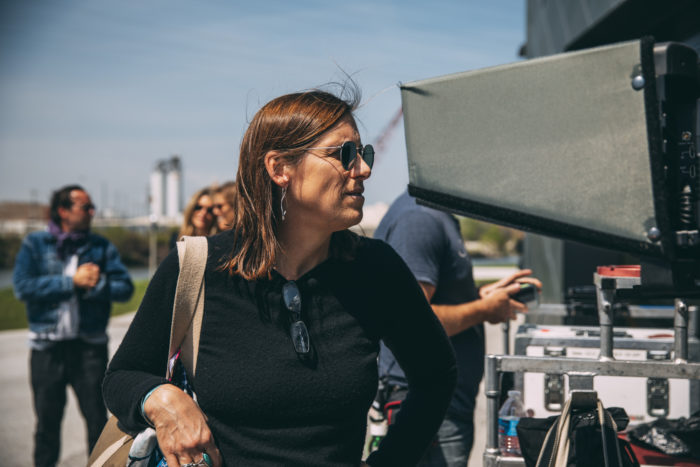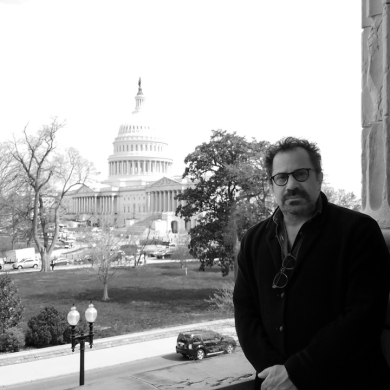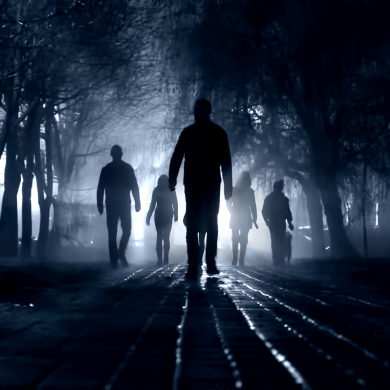Published Date: 07-29-20
By JC Taylor
Mary Mazzio has quite the résumé.
As an Olympic rower, Mazzio spent a summer in the spotlight pursuing a gold medal for the United States – now, she is turning that spotlight to the countless social inequalities plaguing her home country.
Mazzio uses her documentary films to expose injustices. From the sons of undocumented immigrants building underwater robots in Underwater Dreams, to the children and young women who survived horrendous sex trafficking online in I Am Jane Doe, the stories told through Mazzio’s lens highlight the unstoppable spirits of those who have conquered insurmountable challenges.
Now, Mazzio is facing a new challenge: releasing a film during a global health crisis. “I think the events of the past year have been really destabilizing for everybody – in every industry,” Mazzio said.
Her new film, A Most Beautiful Thing, tells the story of Arshay Cooper, a young man from Chicago who captained the first African American high school rowing team in the United States. Many of the young men on the team were in rival gangs on the West Side, yet they came together to row in the same boat.
“A Most Beautiful Thing was supposed to come out pre-COVID, debuting at SXSW” Mazzio said. “We had planned to release in theaters at the end of March. COVID hit, we pivoted to June, then we pivoted to July. And then, of course, we saw the events of this past month, which have made the message of Arshay Cooper in this project even more resonant, powerful, urgent, and timely.”
Urgent is the operative word. As COVID-19 continues to have a disproportionately devastating effect on minority communities, and protests across the nation demand justice for Black victims of police brutality, a story of unity over division may be more important than ever.
Mazzio spoke with CreativeFuture about her athletic roots, how her passion for documentaries was ignited, and how A Most Beautiful Thing is only made more powerful by the backdrop of a country that was built for the privileged.

JC TAYLOR: I think we better start in 1992. Let’s talk about your Olympic experience. What was that like?
MARY MAZZIO: It was surreal. Interestingly enough, Grant Hill was on the 1992 ‘Dream Team.’ I marched in right next to Grant Hill. I knew who he was, he had no clue who I was. And here we are, 20 years later, working together on [A Most Beautiful Thing]. But that experience, especially the opening ceremony, is surreal. That’s the only description I can use. The Summer Games, in total, have about 3,000 athletes from all over the world. You walk in, and everybody is a potential gold medalist. Closing ceremonies are a bit of a different story [laughs]. The chips had settled.
To be able to compete in the highest arena there is, while wearing your country’s colors, is a very special thing. But the important thing for me was not that I became an Olympian, but that I learned how to focus, how to be better around distractions. I started seeing a sports psychologist. They had me doing math problems with the TV on and the radio blaring, so that you had to drill in with laser-like intensity. At the end of a series of months, I could concentrate like nobody else. I could visualize and use the power of the mind to will something into fruition.
Honestly, that is the act of making a film. I don’t care if you’re a feature filmmaker or a documentary filmmaker. Anything that you move forward, you have to will into existence. So, I feel like all of the things I learned in my athletic journey, I have definitely parlayed into this career.
JT: It’s interesting how many lessons you can take from organized sports that stick with you for your whole life.
MM: [The experience of being part of a team] teaches you so much, like how to move forward with something when you are not friends, when you are uncomfortable, when you are unfamiliar.
In a project like A Most Beautiful Thing, I’m going into neighborhoods that I’m not necessarily familiar with. Yet at the end of the day, you understand that every human has a beautiful story. Every human. You think: How do you relate to them? How do you cross those bridges to understand the full continuum of the human experience?
And with a project like this, working with Arshay Cooper, you have one of the most incredible masters of the spoken word. He’s so powerful when he speaks, and so passionate about his message, and he comes from the West Side of Chicago. This is not a neighborhood I had any experience growing up in. I’ve done a number of projects with communities like the West Side, but working with Arshay and these other young men, it’s really been extraordinary. And, by the way, highly illuminating.
All of these young men in the film speak so movingly to the institutional impediments and the racist policies that have hobbled so many communities. I think a lot of people are waking up to the systemic racism that has been endemic for the past 400 years. There were thousands and thousands of George Floyds before George Floyd. These young men speak to that intergenerational trauma that’s scarred not only their families, but their community.
JT: I imagine that that’s one of the most rewarding parts of working on documentaries – learning and being exposed to these different walks of life.
MM: Not only that, but – well, I always thought I would be writing feature scripts, but I’m totally uncool, so I didn’t fit in with that crowd [laughs]. But it dawned on me that documentary film is such a powerful medium. I view what I do as building the scaffolding. I’m building the risers, I’m building the auditorium, so that someone else can take the stage. We can help amplify the voices of people whose voices are not normally heard, voices that are under-represented, and, in doing so, motivate and inspire those in power to take action. You can’t beat that.
JT: How did you get into the documentary industry?
MM: [Laughs] Luck!
I’ll never forget it: I come home from the Games and I’d written a script. I sent two Olympic t-shirts and a copy of the script to Sherry Lansing, who was running Paramount. The next week, I got a call from her office saying, “We need five more copies of your script, and when are you next in LA? We’d like to meet.” I thought it was a joke at first, but it turned out to be real. What I didn’t realize was that everyone in Hollywood has a script. Maybe you make it, maybe you don’t. That’s when I decided to go to film school to learn the craft.
While I was in film school, I happened to make this documentary short, and one guy in the class said, “Mary, you’ve got to go make this.” That ended up turning into a full documentary called A Hero for Daisy.
It was about everything I cared about. It was about this group of female rowers at Yale University in the ‘70s, and this was at a time when Yale had only just become co-educational. Yale’s motto was to train and educate 2,000 male leaders. Talk about privilege and exclusion.
These women went down to the boathouse, on an unheated bus, 20 minutes away from the river, training in the snow and the wind and the rain. Then, they’d wait on the bus for every last man to shower. All the while, these women are freezing cold and getting sick.
So, these women took things in their own hands and said, “This is not fair.” They tried diplomatic channels first but were told that “the wheels of change grind slowly at Yale University.” Unsatisfied with that answer, the team Captain remarked “we pay tuition, just like the boys,” and a plan for dramatic action was hatched.
They ended up storming the athletic director’s office and stripped, with “Title IX” written across backs and breasts. Title IX was the newly enacted federal statute mandating gender equity. These women were saying, “Where’s the equity here?”
This story got picked up by the New York Times and shot around the world. Many years later, I got to meet the captain of the team and she told me the story of this protest. I was amazed. I went to a women’s college, I was an elite athlete, I thought, “How did I miss this piece of history?” Ultimately, that story became my first documentary.
That film went from zero to 60. It became a cult film of sorts and was screening across the nation. That film allowed me to quit my day job and say, “You know what, I’m going to give this a year.”
JT: Many projects later, you have this long list of films that confront social issues and the struggles of marginalized communities. What’s your strategy when making these documentaries?
MM: We try and create films that are easily understandable, but with really beautiful cinematography. People will respond to how things are packaged, and I think that is really important. Others will not agree with me on that – there are a lot of really cool, gritty films that are made. But I remember when we were making an earlier film about young people from the South Side of Chicago, Compton, Harlem… somebody said, “Well, I would have expected your film to be grittier.” I’ll never forget that. I was like, “Grittier?” Why would you ever suggest that I use lower production values because I’m going into a marginalized community? That’s offensive.

JT: So, let’s talk about A Most Beautiful Thing. How did that story first appear on your radar?
MM: So, somebody told me about this book about rowing on the West Side of Chicago. I hunt it down off of Amazon and I tweeted out to the author: “@ArshayCooper: amazing, compelling story!” He tweets back in a nanosecond. And, the next day, the phone rings. It’s Arshay Cooper!
What Arshay told me last week, was that he was tweeting to everybody. He was tweeting to Steven Spielberg, he was tweeting to Denzel – apparently, I’m the only one that picked up the phone.
And, rowing is my sport! From the outset, he was part of my community and I was part of his community. So, when I read his story, it occurred to me that rowing is among the most privileged of sports. But for these young men to discover something really profound on the water, I thought it was an amazing opportunity to talk about lack of access and lack of opportunity. It goes back to the fundamental principle for all of our work: the talent is everywhere. Exceptional drive and work ethic is everywhere. It’s just that access and opportunity are not everywhere. That’s not equally distributed. Which is totally un-American, by the way. And so I feel gratified and humbled in so many ways that Arshay took me on this journey with him.
JT: Do you feel that this story speaks to some of the national issues we’re going through right now?
MM: I think that the film and Arshay’s voice, his leadership, and his message are more resonant than ever. It speaks to all of the issues going on. It speaks to the toxicity between these neighborhoods and law enforcement. It speaks to intergenerational trauma. It speaks to systemic obstacles and racist policies that have been imposed on these communities. It speaks to history and who gets to tell it.
JT: So, do you see this as a movie for a divided nation?
MM: I think it is so restorative when you see what Arshay Cooper does in the film. He reaches out to members of the Chicago Police Department in ways that – literally, I was behind the camera and I cried three times. He is so courageous, and it is his belief that you have to have a dialogue for any meaningful change to happen. Arshay says that if a police officer is to come into his neighborhood, that officer does not know his name, knows nothing about him. He says “I need you to learn who I am. That’s so next time you come in my neighborhood, and maybe you stop a young person of color, you think of me. You understand our greater humanity.”
JT: What impact are you hoping this story has?
MM: Intergenerational trauma began 400 years ago and has continued unabated. You’re seeing greater America wake up and say, “Oh my God. We need to do something.” And Arshay’s story makes it very clear what those impediments are and calls out the injustice of it. At the end of the day, it’s a human rights issue. We’ve got children living in communities all across this nation that are unsafe. There is a profound inequality of safety, and that is so toxic and damaging – not just for children but for their parents. It’s time to do something about it. And if legislation addressing untreated trauma can happen, incredible. And if the project leads to a dialogue about the urgency to reinvest in neighborhoods like the West Side, so much the better.
JT: What do you think it is about rowing that brought the young men of A Most Beautiful Thing together?
MM: Two things that I’ve come to learn:
[Rowing] is like cross country running – it has a rhythm and a meditative opportunity. It’s healing. You don’t have that with football or hockey.
The second thing is that you can’t move forward unless you are moving in complete unison with the person in front of you. So, if you’re not together, you’re not moving forward.



